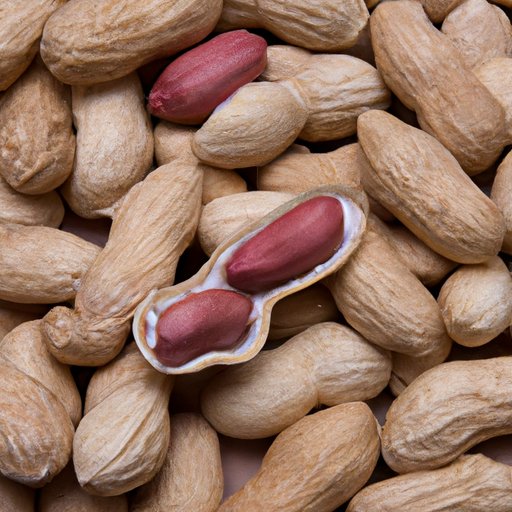I. Introduction
Do you really know what a peanut is? While many people love snacking on peanuts, few know the science behind it. In this article, we’ll delve into what makes a peanut a peanut, their journey from field to table, and more. This article is intended for anyone who wants to learn more about peanuts, from curious individuals to avid peanut lovers.

II. The Nutty Truth: Discovering What a Peanut Really Is
So, what is a peanut? Scientifically, peanuts belong to the legume family, not the nut family. They are classified as legumes because they grow pods underground much like beans and peas. However, due to their taste and culinary use, people often refer to them as nuts.
Despite their name, peanuts are not actually nuts. Nuts grow on trees, while peanuts grow underground. This common misconception likely arose because of their similar taste, texture, and use in cooking. Peanuts are also known as goobers, groundnuts, or monkey nuts, depending on the region.
III. Peeling Back the Layers: The Anatomy of a Peanut
The anatomy of a peanut is quite simple. It consists of three main parts: the shell, the kernel (or nut), and a thin brown skin. The shell is hard and wrinkled, the kernel is smooth and oval-shaped, and the skin is thin and paper-like.
The shell is not usually consumed and is often discarded before consuming the kernels. Peanuts can be roasted, boiled, salted, or sweetened and have a crunchy texture. The taste of peanuts varies depending on the variety of peanuts, which includes Virginia, Spanish, and Valencia.
IV. From Field to Table: Understanding the Journey of a Peanut
Peanuts are grown in warm and well-drained soil. Their cultivation process begins with planting seeds, and they grow underground. Once they mature, they are harvested and washed. The kernels are then roasted (or not) and either sold raw or are made into products like peanut butter, peanut oil, and candy.
Peanuts are widely used in many cuisines for their unique flavor, texture, and nutritional benefits. They are especially prevalent in Asian cuisine, where they are used for anything from noodles to sauces to snacks. They are also used as a source of protein for vegetarian and vegan dishes.
V. Allergies Unpacked: Why Only Some People React to Peanuts
While peanuts are a healthy and tasty snack for many, they can be life-threatening for people with peanut allergies. Peanut allergies are more common in children than adults. The reason why some people develop allergies while others do not is still not entirely clear, but some factors may contribute, such as genetics and environmental factors.
When someone with a peanut allergy consumes peanuts, their immune system identifies the peanut protein as a foreign substance and releases chemicals to protect the body. These chemicals can trigger the allergic reaction and cause symptoms such as hives, swollen lips or throat, and even anaphylaxis.
VI. The History of the Humble Peanut: How it Became a Staple in American Cuisine
Peanuts are believed to have originated in South America, where they were a staple food for the indigenous people. The Spanish brought peanuts to Europe during the 16th Century, and then African slaves brought them to North America a century later. However, it was not until the 19th Century that peanuts became a popular snack food in America.
As early as the 1800s, peanut butter was marketed as a health food, and by the 1900s, peanut butter and jelly sandwiches became a popular meal idea. Peanuts also became popular as a snack food at baseball games. Today, peanuts continue to be a popular ingredient in American cuisine, and there are countless ways to incorporate them into your meals.
VII. The Environmental Impact of Peanut Cultivation: Should We Be Concerned?
While peanuts are a delicious and nutritious food item, their cultivation does have some potential environmental concerns. Peanuts require large amounts of water and land, which can cause soil depletion. Also, farmers may use pesticides to prevent crop damage, which can be harmful to the environment and human health.
However, there are some steps farmers can take to reduce these impacts. For example, some farmers use methods like crop rotation to rejuvenate the soil. Additionally, some companies are developing sustainable practices for peanut farming to lessen the use of pesticides and improve water management.
VIII. Get to Know the Peanut Better: Recipe Ideas and Nutritional Benefits
Peanuts are a nutrient-dense food that is high in protein. They are an excellent source of vitamins and minerals, including B vitamins, magnesium, and zinc. Peanuts are also rich in healthy fats, which can help reduce the risk of heart disease, stroke, and other health issues.
There are countless ways to enjoy peanuts and incorporate them into your recipes. You can use them for garnishing soups, salads, and curries. You can make homemade peanut butter, which can be used as a spread dip. Also, you can use peanut products like peanut brittle or roasted peanuts as a snack.
IX. Conclusion
From their nutritional benefits to their rich history, peanuts are a fascinating food item. While they are a common snack food, there are countless ways to incorporate them into your meals and make them a staple in your cooking. We hope this article has given you a better understanding of what peanuts are, how they are grown and used, and how to use them in your cooking.
Whether you are a fan of peanuts or not, we encourage you to experiment with them in your recipes and learn more about this fascinating food item.
